DZone recently caught up with me to discuss RIA's Web 2.0 and SOA as well as other trends in enterprise architecture. In this interview, recorded at Adobe MAX 2009, we revisit the notion of 'Web 2.0' and discuss the architectural patterns behind it in the context of the O'Reilly book "Web 2.0 Architectures". We also discuss some of the new architectural and human interaction patterns that are shaping the way in which we build Web applications today as well as some of the new Flash authoring tools for the iPhone, the Open Screen Project, as well as the impact HTML 5 will have on Flash adoption.
The complete transcript of the interview has been provided here.Canadian Cybertech assists with Clean Technology adoption ranging from software systems architecture, system design and advancement of user experiences/security. We have over 25 years of experience helping companies gather the full and auditable requirements for IT projects to ensure success.
Wednesday, December 23, 2009
Tuesday, December 22, 2009
Saturday, December 12, 2009
12 Ideas for an Environmentally Efficient House
1. House design is essential. I plan to re-route all hot air evacuations (bathroom fan, kitchen fan, clothes dryer (if we get one) exhaust etc.) into either a thermal bus or to tie them directly to a year round greenhouse to use the thermal energy for growing food.
2. IMPORTANT: Always do the “Net” energy calculations. For example – having cheap, Chinese made solar powered, LED lights to power your walkway instead of investing in a proper system is a waste of time and an affront to the environment if you have to throw out something that broke in one year and took 25 times as much energy to make as it saved. For example, I bought these little solar powered lights at Home Depot, which lasted only about 250 days. When I took them apart, I discovered the culprit – a single AA rechargable battery was the only power source. These usually do not last more than 250 charging cycles and if you connect one to a daily charge routine, it will burn out in less than a year. Net result: I actually polluted more by buying cheap goods to save energy.
3. I also plan to use wood heating with a proper catalytic converter (avoids most carbon pollution) to warm the house on winter days as we have ample wood for cooking etc. The house we are choosing has a small horizontal footprint and is 2.5 stories high, which allows thermal energy to be more efficient.
4. I'm putting the shower and kitchen on the top floor then using a diverter valve to reroute the entire waste water into the flooring for either keeping the house cool in summer or heating in the winter.
5. After the electrical inspectors give the final OK, I am moving to 12 or 24 VDC power for all lighting in the house and possibly some USB outlets. All lighting will be 12/24 VDC LED indirect. This saves tons of energy over trying to convert a 12/24VDC battery array into 110 AC (or in your case 220 VAC, which would be less efficient). Most solar and wind systems use 12 or 24 VDC as the charging output. Energy can neither be created nor destroyed and it is a lossy process to convert energy. The biggest culprit is usually thermal energy as an unwanted byproduct (think of hot transformers). If you must convert, try to capture the byproduct (place the converters in a place that needs heating).
5. My wife and I are investigating thermal heating systems. These seem to make a lot of sense as they can be used in both the summer and winter. In North America, there is an relevant organization that has members; there might be a similar system in the UK - http://www.geoexchange.org/
6. In order to use wind energy in a micro manner, there are lots of manufacturers and the kits are not that hard to figure out. The first thing you have to do is check out the MET office to find out if it will work in your location. Wind speed must be at a minimum of 5 metres per second to work. The Canadian map showed us that in our case, we have sufficient wind. http://www.windatlas.ca/en/nav.php?field=E1&height=50&season=ANU&no=45.
7. Solar kits are also not that complicated. Study up on it and note the major components – collectors/charge controllers, battery array/inverters or converters then do the calculations. You have to figure out what you want to use the property for before you can plan a system. In our case, assuming we only go there on the weekends, we can go with less collections and a bigger battery array as the battery array will recharge during weekdays. If we lived there full time, we would have to use more collectors. Most manufacturers of repute (Siemens, etc/) will have all the calculations available. There are some good resources online for this too. Here is one: http://midsummerenergy.co.uk/solar_panel_information/solar_panel_calculator.html#nogo
8. Look into evacuated solar tubes. These work in very low temperatures (as low as –40 degrees Celsius) and can deliver off grid water at 65 degrees Celsius. They work by having no gas (a vacuum) in between the outer tube and the inner collector. This collects energy radiated from the sun without the atmosphere moving the heat away and harvests it via the manifold. http://www.solarthermal.com/products.asp These can take care of big things like hot water tanks.
9. If you use your property for weekends only like me, you might want to consider a Linux micro kernel running a small routine that can be used to “wake up” the house. For example, if you have a grid tied-hot water system, you could invoke a cron job that turns your hot water heater on and off remotely so you’re not paying for energy you don’t need. Another option is to move to a EU style JIT hot water heater (tank-less system).
10. For certification, The SRCC (Solar Rating and Certification Corporation) is the key solar collector certifying body for the US and Canada. Make sure everything you use has passed the minimum criteria for this.
11. My thoughts on this are that when I buy my supplies, I want to do it with a company that has been around, been certified and is backed by a manufacturer with a warranty and good history, and someone who has a physical office I can identify and walk into. Too many snake oil vendors on the web.
Thursday, December 10, 2009
50 Free Citrify Licenses!
Visit http://www.citrify.com/promo/
Citrify is photo editing software built using Adobe AIR. It runs on Linux, Mac and Windows. Very cool use of AIR!
Submit the form with this promo code in the message body: duane1209
Here are some screenshots of our key features: http://www.citrify.com/features/
Here is more information about our team: http://www.citrify.com/about/

Thursday, November 26, 2009
Flex Builder Linux Alpha 5 release
Tuesday, November 10, 2009
How to deploy Axis2.war to JBoss 5
So how do you solve it? It is not too hard but a bit tricky. First, open up the axis2.war file. On Mac OS X, you can do this by using StuffIt.app. Just navigate in finder to the directory containing axis2.war, control-click, select “Open with…”, and then choose ~/Applications/StuffIt.app. This will expand the WAR file in the same directory.
Within the directory, there are two files you have to get rid of. I first tried to delete xml-apis-1.3.04.jar and xercesImpl-2.8.1.jar thinking that should work. This is shown below.

It actually did but lead to another problem (later). To get all the files back into a war, you have to do two things. The first is to use the command "jar -cvf

After this, on a Unix-based system, you have to change the permissions to ensure the file is usable by the app server. Use the chmod 775

Figuring I had this problem licked, I started up the appserver. It started fine, however when I went to navigate to the http://localhost:8080/axis2/ URL, I got another error. This time is was a mismatch in impedance between the JSP servlet jars. The error comes out as "The method getJspApplicationContext(ServletContext) is undefined for the type JspFactory". The problem is that the build of axis2 I downloaded had an older version that did not have the same method. Once again, to rectify this, open up the axis2.war file and remove another file called "servlet-api-2.3.jar". Repackage the war file and chmod it so that it is executable by the app server.


Sunday, November 08, 2009
Flash Builder 4 Tutorial - AMF
Wednesday, November 04, 2009
Video Tutorial - Flash Builder 4 Graphics
Tuesday, November 03, 2009
Best Duane's World Episode ever
Monday, November 02, 2009
Fastest Broadband Service in the UK?
When I travel for Adobe, I expect some minimal comforts. Good hotel, good food, good car (if applicable) and more. Good Internet is the least I expect so I set out on a quest to find the best broadband in the UK. Finding a good high bandwidth hotspot is hard though. Nevertheless, my googling fetched an availability checker. All you do is hit in your postal/zip code and get an immediate response with the best deals and offers for broadband service for individual ISPs. The availability checker coughed up a list of multiple, fast broadband connections, prices, terms etc. I checked out a broadband comparison between ISPs, read a couple of reviews. Finally found one that suits my needs (namely does not compromise on the speed).
If you live in the UK or are passing through for a couple of days, you may want to try the broadband availability checker.
Monday, October 26, 2009
Nokia Sponsors "Web Professional Minute" with me
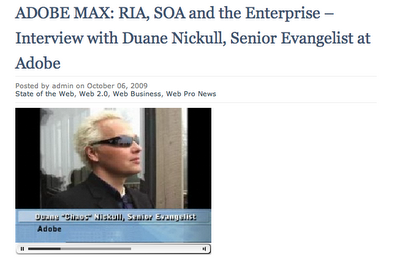
Here is a very short interview I did with Bill Cullifer (always a treat to work with him!) during the recent Adobe MAX event in Los Angeles, CA. The entire interview can be heard or downloaded here. Thank you once again Bill!
Saturday, October 24, 2009
A tribute to my Great Uncle - one of the smartest people ever!
Kenneth Ross MacKenzie
Professor of Physics and Astronomy, Emeritus
Los Angeles
1912–2002
Kenneth Ross MacKenzie, who made contributions to nuclear physics, particle accelerators and plasma physics, died July 3, 2002 at age 90, following complications resulting from a series of small strokes, at his home in Los Angeles, California.
Ken was born in Portland, Oregon. The family moved to Victoria, British Columbia when he was 10 years old. He received bachelor’s and master’s degrees from the University of British Columbia, and began further graduate study at the University of California, Berkeley, in 1937.
The longstanding vacancy in the periodic table at element 85 ended in 1940. Carson, MacKenzie and Segre, in the Physical Review, reported "Artificially Radioactive Element 85". They bombarded Bismuth-209 with alpha particles to produce what was suspected to be element 85-211. Physical, chemical and even physiological evidence confirmed the assignment. After a reminder to do so, in a 1947 Nature article, they named the element "Astatine", which means unstable in Greek. All 31 of the isotopes of Astatine are unstable.
When Ken began working in the Radiation Laboratory, the 60-inch cyclotron was nearing completion. He became involved with the radiofrequency (RF) system which produces the D-voltage. With this beginning he became an authority on RF systems. He made a major contribution to the design of the system for the 184-inch cyclotron which was completed in 1947. It was the first machine capable of producing mesons. He also made significant contributions to the system for TRIUMF, the meson factory which was completed in 1974. RF systems can be temperamental. Ken had an uncanny knack in getting them to perform properly.
Ken contributed to the development of cyclotrons from day one. He was in Berkeley when the first tests of large-current Uranium mass spectrometry were made in late 1941. He participated in the full scale tests which were made in the recently completed 184-inch magnet, beginning in mid-1942. An accelerating voltage had to be held constant with great precision. The system developed, involving RF signals, is described in a chapter which he contributed to a book in the National Nuclear Energy Series, Manhattan Project. Ken also went to Oak Ridge where he participated in the process of getting the production plant into operation.
In 1964 Ken wrote a paper titled "Space Charge Effects and Cyclotron Beam Enhancement." Cyclotrons had been in operation some thirty years and this effect had been overlooked. Near the center of a cyclotron there can be appreciable loss of particles which are near the surface of the circulating current due to repulsion by those particles within the body of the beam. Once the effect was recognized, steps could be taken to reduce it. As a result, several large synchrocyclotron laboratories were able to increase their research output.
McMillan and Veksler, during World War II, predicted means of increasing the upper energy limit of cyclotrons. The first test of the proposal was made in Berkeley in 1946. The 37-inch magnet was modified for the test. Ken participated, not surprisingly, in the design of the RF system, which now involved frequency modulation. The prediction was confirmed.
After World War II, UCLA was interested in establishing a program in nuclear physics. It was decided to move the 37-inch frequency-modulated cyclotron to UCLA to begin the new program. After a year at the University of British Columbia, Ken joined the UCLA faculty in 1947. Over the next 10 years he and his students performed positron-electron scattering experiments, stopping power measurements, precision range-energy relationships and a final increase of the "37-inch" energy to 20 Mev protons.
In about 1960, Ken initiated the UCLA Department of Physics program in experimental plasma physics. Over the next 15 years, with various colleagues, he published some 20 papers in this field, many involving various aspects of large quiescent plasmas. Early on, Ken and his students lined the walls of a vacuum chamber with permanent magnets of alternating polarity to suppress plasma electron losses. "MacKenzie buckets" are now universally used as plasma sources. He initiated an introductory undergraduate course in plasma physics and an accompanying laboratory (which used a restaurant size cooking pot as an ion bucket). He invented simple physical pictures for a number of plasma wave phenomena usually described in complex mathematical terms.
Ken can be given much credit for the impressive status of experimental plasma physics at UCLA today. Studies of plasmas in the ionosphere (Alfred Wong); the physically largest Electric Tokomak (directed by one of Ken's students, Robert Taylor); and physically large plasmas for wave studies (Reiner Stenzel and Walter Gekelman) are examples of important work in progress.
For a period of about two years Ken was the president of a small company, Meva Corp, which was formed to build cyclotrons. After producing one for an undergraduate laboratory at Pomona College, the company was sold to Hughes Aircraft.
After retirement, Ken continued a long standing interest in Special and General Relativity. Some results are described in an unpublished monograph titled Einstein's General Relativity in Three Dimensions. He also wrestled with the dark matter enigma.
Ken made very significant contributions to the Department. In a broad sense, being one of eight new faculty appointments following World War II, he participated actively and fully in every aspect of the Department's development. Over the years he saw to it that the electricity and magnetism laboratories were kept up to date. He introduced the plasma physics curriculum. He took the course in “Physics for Non-Science Majors” seriously, devoting a great effort to make special relativity understandable. In the mid-70s he served as chairman.
What kind of a physicist was he? He could of course use mathematics to formulate and solve problems. Beyond that, he could see through the most complex situations to their conceptualization and solution. As a person, he was gentle, kind, understanding, pleasant and modest to a fault. He rarely, if ever, raised his voice. He had a considerable range of interests outside of physics, both physical and intellectual. Verna, his second wife whom he married in 1981, gave him great care during his decline. Other survivors are his children, Robert, Maryann and Wallace. They miss him dearly as do all who knew him well.
Thursday, October 22, 2009
San Jose Parking ticket scam?
What happened in San Jose, CA in July 2009 is an illustration of how flawed parts of the US justice system are. After a recent business trip, I was surprised to get a letter from Hertz in the mail claiming that I had received a parking ticket. My surprise came as the car had been driven from San Francisco to San Jose directly to the Fairmont valet stand and parked until the day I left. The day I left, I picked up the car and drove to return the car (after refueling) to the airport. The car was NEVER parked for even a second on any city street while in my possession. The valets also attest that it was parked underground the entire time.
My first impulse was to suspect that the valets had taken the car out but when I examined the time, it turns out that was not possible. Rather than repeating the facts, here is the letter I wrote to the City of San Jose:
"Re: Citation Number 90018947
Dear Sir/Madam:
I am writing to dispute a parking citation apparently issued to a car I had rented. This alleged violation was stated to have occurred on July 23, 2009 on or around 9:49 AM at or nearby South 125 Market Street. The vehicle in question was rented to me by Hertz and was in both my possession as well as the possession of the Fairmont Hotel Valet staff. It was never parked where the incident allegedly took place and I am writing to ask you to formally review this ticket and to formally dispute this matter.
I first saw the violation notice upon my return from a trip to Germany the week of September 14, 2009. I have enclosed a photocopy of my return flight boarding pass as per our conversation.
On the morning the alleged violation took place, here are the chronological sequence of events:
9:25 (Approximately) – I called the valet service to request the car be ready for me. They informed me it would be available in the underground parking lot of the hotel (NOT on the street level).
9:36 AM – I check out of the hotel via the front desk. I have attached a copy of the email verifying this from the hotel manager. I immediately walked out the south door to grab breakfast.
9:38 AM – I paid for my breakfast after ordering a toasted bagel. The clerk put the bagel into the toaster. I have attached the receipt for your perusal. The original is on file with Adobe systems as part of my expense reports.
9:44 (Approximately) I received my order and started to eat it.
9:47 (Approximately) I finished breakfast and walked to the valet station and took possession of the rental vehicle. You can verify this by requesting the video footage from the Fairmont Hotel.
After taking possession of my car, I drove directly out of the hotel parking lot, stopped at the red light to turn towards the Park Avenue, then proceeded to the 101 freeway via Guadalupe. I drove directly to Burlingame where my next stop was recorded before returning the vehicle to Hertz at San Francisco Airport. At no time did I stop or park this car. At no time did anyone put a parking ticket on the car. I was in the car the entire time. You can verify this by requesting video footage form the front facing cameras from the Fairmont hotel.
9:49 is the time of the alleged parking violation. The car was never parked.
10:27 (Approximately) I had stopped at the Burlingame gas station (34.7 miles from the hotel) to refill my rental car before returning it. I arrived, walked inside, provided $40 cash to the attendant, went back outside, fueled the vehicle, then returned inside to pay. To cover the distance between the Fairmont Hotel and the Gas station, the calculations reveal a person averaging 45-50 MPH would take approximately 45 minutes to cover the distance. At 60 MPH, a person would cover 45 miles in the same time. Keep in mind the time – post rush hour on a weekday on the 101 and the fact there were traffic lights at each end. 45 minutes is probably a BEST CASE scenario. It is highly unlikely anyone could make the trip faster, which is what would have been required should parking a car be included.
10:33 I paid for the gas AFTER refueling. The receipt (enclosed) shows a time stamp of 10:33 AM July 23. It took approximately 5 minutes to refill and the fact this was in post morning rush hour traffic.
~10:50 The car was then returned to Hertz at SFO.
I never stopped anywhere during this trip as I was focused on making my flight to return home to my family.
I also took the time to contact the hotel to see if perhaps one of their staff temporarily parked the car outside on the street. They reviewed their security tapes and have verified the car was only in the hotel basement. In any event, they store the cars underground in the valet parking area so it would not have been on the street.
You can see why a prudent individual might question the validity of this ticket. I wish to ask you to please investigate this matter further and let me know what you can find out.
I also hereby swear and will swear under oath that I did not park the car anywhere on my trip to the airport, other than to stop at red lights. I certainly would not have picked up the car only to park it somewhere on the same block I had just walked past. It does not make any sense.
Sincerely
Duane Nickull"
Please note that copies of all of the receipts with the time stamps were sent back to verify the times. The result? I got a letter saying "We are unable to verify your claims the alleged infraction never occurred". Idiots!! First off, according to most law books, is the onus not on the accuser to prove the allegation? How can someone logically defend themselves from something they did not do? If I was not there, what possible evidence can exist to allow me to clear my name (other than receipts at the same time showing that I was in different areas, which I had sent)? It only shows that the city of San Jose parking enforcement division is staffed with simians who fail to comprehend basic logic. I really hope someone grasps this concept and can turn things around. How can the people of San Jose let their public servants drop to such a low standard???
If I had to try again to defend this, I guess I could start with the basic items that come to mind. First, there was NO PARKING TICKET placed on the car. Yes - this is true and was admitted to me by the city of San Jose. Apparently the person issuing the ticket was not able to place the ticket on the car. Hmmm - could this be a strong indicator that the car was never parked and was in fact in motion??
Second, perhaps we should examine this from a "what if" point of view. If I had forgotten something at the hotel and wanted to go back, what option would I take?
1. leave my car on parked on the street outside the hotel where it risks getting a ticket; or....
2. Give it back to the valets, who would look after it and not charge me anything for such a service as I had just paid them? I am a President's Club member at the Fairmont too.
My bets would be on number 2. Since the car was never parked, this is all moot anyways.
Third, would it be conceivable that some public servant in San Jose is issuing bogus tickets to rental cars as they drive out of the hotel driveway so they can fulfill their daily quota then simply lay around in the sun the rest of the day and not work, thus wasting taxpayers' money? Would that be a likely scenario?
I leave it for you to judge. In the mean time, I have a bitter taste in my mouth after realizing the effort and expense to fight this is not worth it and I have to pay.
It's the perfect system:
- Guilty until you can prove conclusively you are innocent (logically impossible).
- The cost of exposing the truth is far too expensive compared to the cost of admitting to do something you never did. (inconvenient at least).
- The truth will never be exposed since no one is likely to look into it.
Land of the free? I hope someone from the city of San Jose reads this and decides to investigate the person who issued the ticket.
I was not even allowed to discuss it with them. I have no rights in the United States of America. After all - I am a Canadian.
Wednesday, October 21, 2009
RIA Radio, Live at Adobe MAX - Duane Nickull - InsideRIA

Here is an interview I did with the InsideRIA guys (Garth, Zach, Leif et al). This is probably the best and funnest interview I have done lately. I hope you enjoy it. RIA Radio, Live at Adobe MAX - Duane Nickull - InsideRIA
Monday, October 12, 2009
New Video: 22nd Century performing in Los Angeles, CA
The first CD is starting to pick up in sales @ http://www.cdbaby.com/cd/22ndcentury. Only buy it if you really want to support the band. You can also download the 22nd Century MP3s from our MySpace (free). The CD offers far better quality in AIFF format.
Either way is cool with us. We don't do music for money but totally appreciate people who support the band via buying CDs.
22nd Century - U Generation (live) v2
22nd Century|MySpace Music Videos
Thursday, October 08, 2009
Video Tutorial - 3D effects in Flex/AIR in 5 minutes
Tuesday, October 06, 2009
Adobe MAX Sleeper News? RIM!
Via the OSP, 19 out of the top 20 mobile handset manufacturers are now collaborating with Adobe to integrate Flash technology into their devices. MAX's mobile story gets even better when you consider Adobe and Nokia are jointly announcing the funding of more than 35 multi-screen applications as part of the Open Screen Project Fund.
Now to go and teach the 4 hour AIR/Flex Boot Camp!
Monday, October 05, 2009
Flash - iPhone announcement.
This caps a long running stealth like program code named "notus" within Adobe. While we just announced this today, there are several apps available today via the App Store. There are details published at adobe.com/go/iphone.
Does this mean iPhone supports Flash? No. Apple has not yet announced support for Flash on the iPhone. So what does this really mean? It means there are hundreds of thousands developers who can use their existing skills to build iPhone apps via CS5. From a consumer/user perspective, these applications appear and work just like any other iPhone application. Users cannot easily determine which applications were built with CS5, native objective C code, or even using something advanced like Nitobi's PhoneGap.
Will we use this exclusively? No. Many developers use whatever makes them productive. Another major announcement today was the addition of an iPhone mobile client for Adobe LiveCycle ES. This was built using objective C. Developers who have ActionScript skills though will be able to build applications using a language and IDE they are familiar with and not be forced to learn another application programming language. This is huge IMO and will help both the Apple and Adobe developer ecosystems.
Adobe has not yet made any breakthrough WRT to getting Apple to put the Flash player natively on the iPhone. I don't work with the people who are having the talks but I get the feeling (mine - not necessarily the truth) that Apple and Adobe haven't made much progress on this front. I do know there are tons of people who want this so I am not sure what is going to happen. I have heard that much of the issue is licensing. By the same token, PhoneGap also ran into issues with licensing. I hope Apple listens to their developers.
I am going to build an application later this month to try it out. In the meantime, if you go out and build one, please leave a shout here to tell others.
Sunday, October 04, 2009
List of Adobe Evangelist Twitter handles
@ashorten - Andrew Shorten
@Beatlejase - Jason Levine
@BenForta - Ben Forta
@duanechaos - Duane Nickull
@ddura - Daniel Dura
@garazi - Greg Rewis (Web Standards)
@gregorywilson Greg Wilson
@jlward4th - James Ward
@karlsoule - Karl Soule' (Video)
@LeeBrimelow - Lee Brimelow
@mcorlan - Mihai Corlan
@markadoherty - Mobile and Devices
@Mesh - Mike Chambers
@parkerkrhoyt - Kevin Hoyt
@pburnett - Paul Burnett
@rufusd - Rufus Deuchler
@RyanStewart - Ryan Stewart
@SJespers - Flash Platform
@_ted_ - Ted Patrick
@tomkrcha - Tom Krcha
@tpryan - Terry Ryan
@adrocknaphobia - ColdFusion
LiveCycle ES Pre-Conference Session at Adobe MAX
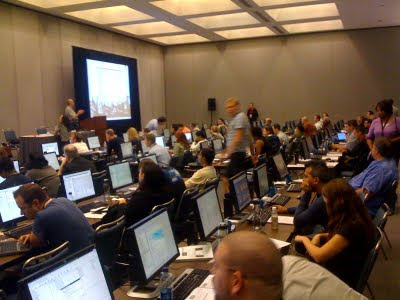
The room is SRO with 80 strong in attendance. This session has more attendees than Russell Brown's Photoshop session! This goes to show that Adobe's enterprise story is stronger than ever and starting to really pick up in the mainstream.
Oh - if you're not coming to MAX, you can still get the materials from the course. Stay tuned here for more updates. Gotta get back to Workbench now.
Ciao!
Friday, October 02, 2009
Rules for denying people fun!
Thursday, October 01, 2009
SmartForm from Avoka
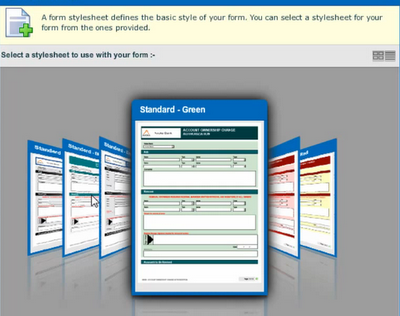
SmartForm Composer is a web-based Flex application that makes it really easy to build high quality forms. With Composer, you simply select one of the pre-defined Smart Templates, and you’ll end up with an intelligent and interactive Adobe XFA compliant PDF SmartForm that looks great, no matter what your design skills. SmartForm Composer makes SmartForm creation:
- Easier – people without programming skills can create them
- Faster – form creation time drops from days to hours
- Cheaper – driving SmartForm costs down by an order-of-magnitude
SmartForm Composer will be demonstrated at the Adobe MAX User Conference October 4–7, Los Angeles, CA. If you are planning to attend MAX this year, come and see SmartForm at booth number 434 for a demonstration.
For more information about Composer visit: http://www.avoka.com/composer
For video demos, please visit: http://www.avoka.com/composer/youtube_main.shtml
Wednesday, September 30, 2009
Flex/AIR Video Tutorial - working with Audio
Tuesday, September 29, 2009
Thursday, September 24, 2009
Duane's World Episode 23 - Adobe MAX Part 2
The code and tunes segment features a new tutorial on Flash Builder 4's Wizard to connect to Web Services using the Flex 4 framework. (Flash Builder 4 is the new revision of the product formerly known as Flex Builder. Flex 4 is the new generation of the framework).
Thursday, September 17, 2009
LiveCycle Sessions at MAX Update
This blog post is intended to be an update to reflect some of the latest news. For starters, I want to highlight a sleeper session that I think will be really cool:
Harnessing the Value of User-Centric Applications
See how Deutsche Telekom is using Flex + Adobe LiveCycle in combination with its enterprise systems to streamline and improve HR communications with over 100,000 employees and retirees. Learn about Adobe’s vision for user-centric computing and see an in-depth demonstration that illustrates how the Flash Platform + LiveCycle ES2 together improve customer experience and employee productivity.
Why is this cool? Nothing tells a story like a customer use case. An independent third party who can share their triumphs with LiveCycle ES. I'm going if I do not have conflicts.
The LiveCycle numbers continue to grow, and we now have more sold out sessions. Yes, a VERY NICE surprise for us after 3 years of constant promotion.
LC Pre-conf training:
SOLD OUT
But in the famous words of Douglas Adams, "Don't Panic"! There are still plenty of sessions left. Just don't leave it too long if you don't want to have to wait until next year to find out why LC ES skilled developers are in super high demand. Register today!
LiveCycle Developer Sessions (repeat twice) with spaces left as of today:
What’s New in LiveCycle ES Next
Effective Form Design for Developers
How to Architect Adobe LiveCycle ES into your Enterprise Solutions
Understanding the Building Blocks of Adobe’s Solution Accelerator Program
Developing for Information Assurance with LiveCycle ES
LiveCycle Community Resources Uncovered
LiveCycle Developer Labs (repeat twice) with spaces left as of today:
Developing Applications using LiveCycle ES Workbench Next
The Next Generation of RIA’s in the Enterprise (UPDATE: JUST SOLD OUT!)
Advanced Process Design using LiveCycle Workbench ES
LiveCycle Guides Next – A Common Data Model Applied
Developing Enterprise Solutions using Adobe Solution Accelerators
LiveCycle Envision Sessions with space left as of today:
Harnessing the Value of User Centric Solutions
Enterprise Apps that Work the Way People Work
Next Generation Clinical Trial Apps
Business Value of User Experience
Partnering to Deliver User Centric Solutions
SOA and Services Camp Developer Labs with spaces left as of today:
LiveCycle ES for Service Orchestration (Hands on Lab)
Building AIR LiveCycle Desktop (Hands on Lab)
SOA and Services Camp Developer Sessions:
Enterprise Cloud Computing: LiveCycle Express
Adobe Services, SOA, and Cloud Roadmap
Flex/LC DS Developer Sessions:
High-Performance Real-time Messaging with Flex and LC DS
Introduction to BlazeDs and LiveCycle DS
Integrating Spring with BlazeDS and LC DS
Flex/LC DS Bring Your Own Laptop lab:
Making Real-time data Come alive with Flex Data Services
Flex/LC DS Developer Labs:
Model-driven Development with Flash Builder and LC DS:
BlazeDS and LiveCycle DS in the Cloud
Flex/LC DS Pre-conf Lab:
Using Data Services to Power Flex Applications
Accessibility Developer Session:
Building Accessible LC Forms
ColdFusion Developer Session:
Making the most of CF and LiveCycle
Platform Roadmap: Flash Platform Servers and Services: 25
Register today! Come to MAX. Learn, drink, party!
Tuesday, September 15, 2009
Duane's World Season Two Opener!
The interview with James is very cool as he is very modest about RedMonk's accomplishments. RedMonk has been voted a major force in the IT industry and has re-written a lot of the rules of how the analyst industry works in IT.
Lee Brimelow Adobe MAX promotion
Friday, September 04, 2009
Adobe MAX promotional offer
Regular pricing is here: http://max.adobe.com/registration/fees/
Promotion code: DAN992
Discount Price $1095 for full conference and $1595 for LiveCycle
Expiry: The program lasts for one week and you must use the code by September 11.
Terms & Conditions
The following general restrictions apply to all special Adobe MAX 2009 registration promotions:
Offer good for new Adobe MAX 2009 registrants only. Offer good for Adobe MAX 2009 full conference pass registration only. Offer cannot be combined with any other offer, package or registration code. Offer expires at 11:59pm PST on September 11, 2009. Offer is not transferable and valid only for intended recipient. Void where prohibited. Terms and conditions for Adobe MAX registrations will also apply.
Instructions for Redeeming Discounts with Promotion Codes
Adobe MAX 2009 takes place October 4-7 in Los Angeles, California.
Learn more about Adobe MAX worldwide online at max.adobe.com
Follow these steps to receive your Adobe MAX 2009 registration discount:
Step 1: Visit the MAX 2009 registration site at max.adobe.com/register
Step 2: Select the button for "Yes, I have a promotion code."
Step 3: Enter promotion code DAN992
Step 4: Complete the steps for online registration.
Step 5: Come to MAX and party with us!!! Don't forget to come to the special MAX bash and see the band 22nd Century play live!

Wednesday, September 02, 2009
New Video Tutorial - Drawing Lines in Flex
I never realized the irony until now that I had scribbled over the nice lines Eddie Van Halen had hand painted onto his EVH Frankenstein (the guitar I am playing in the photo below). This was by far one of the best guitars I have ever played in my life.
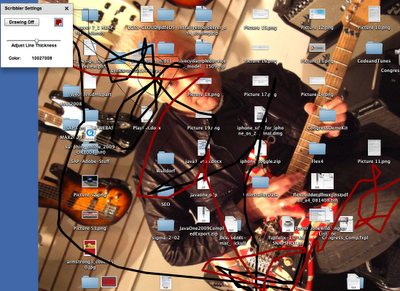
If you want the full source code for this, please email me dnickull at adobe dot com.
Tschuss!
Tuesday, September 01, 2009
The First new Flex 4 book!!!
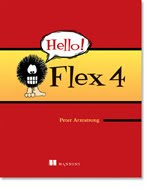
The book is currently in the Manning Early Access Program <http://manning.com/about/meap.html> , which enables readers to get the book as it's being written. If you or someone you know is eager to get started with Flex, this would be the perfect primer to pick up.
Here is what the site says about the book:
| Table of Contents | Resources | |
| 1. Getting started - FREE 2. ActionScript 3, XML and E4X - AVAILABLE 3. Hello Spark: Primitives, Components, FXG and MXML Graphics and Video - AVAILABLE 4. Beyond Basics: Spark Containers and Layouts, View States, Effects, Styling and the Component Lifecycle - AVAILABLE 5. Halo Flex 4: Using Halo Components like DataGrid, ViewStack, TabNavigator Accordion and Title Window - AVAILABLE 6. Building User Friendly Forms using Flex Formatters and Validators - AVAILABLE 7. Building a Real Application using Cairngorm: SocialStalkr, A Twitter plus Yahoo Maps Mashup - AVAILABLE |
| |
DESCRIPTION
With Flex 4 you can easily add color and life to your web applications by introducing dynamic user features, slick transitions, and eye-catching animations. Flex also provides powerful data handling capabilities so you can build industrial-strength applications. And it's open source, so you can get started without forking over a lot of your hard-earned cash.
We think it should be just as much fun to learn Flex as it is to use Flex. Hello! Flex 4 shows you everything you need to know to get started with Flex 4 without bogging you down in obscure detail or academic edge cases. In this entertaining, hands-on book, you'll quickly move from Hello World into the techniques you'll need to use Flex effectively.
You'll start by progressing through 26 self-contained workshop items, which include everything from small one-page examples, to a 3D rotating haiku, to building a Connect Four game. Finally, in the last chapter you'll build a full Flex application called 'SocialStalkr': an interesting mashup of Twitter and Yahoo Maps that lets you 'stalk' your friends by showing specially formatted Twitter tweets on a Yahoo map.
WHAT'S INSIDE:
- Create engaging animations and transitions
- Handle and manage user input
- Access and display data
- Communicate effectively with the server
- Build a complete Flex 4 application
Whether you're a weekend developer or you have great plans for Flex, Hello! Flex 4 is a great place to start.
Tuesday, August 25, 2009
Video Tutorial - drawing circles in Flex 3
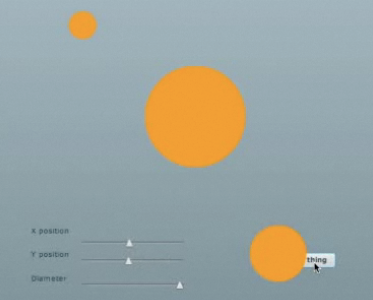
Video:
This is a simple tutorial on how to draw circles using the flash.display.* package. The tutorial will show you how to build a simple application that will enable you to place a circle anywhere you want and understand the code behind it.
If you want the source code, please email me dnickull at adobe dot com.
Get to Adobe MAX 2009 to see more like this at the 2009 Adobe AIR and Flex Boot Camp being taught by James Ward and myself. Register before the August 31 deadline for the special prices detailed here:
http://max.adobe.com/registration/fees/
Monday, August 24, 2009
I am back from Sabbatical, MAX 2009 update!
I have a lot of email to wade through, phone calls to return and tons of promises to get back to people on various things. Please forgive me if I don't do this all at once. This image tells the story (this is just my gmail account, not my Adobe account).
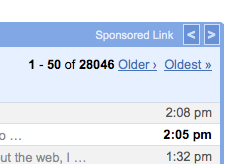
I will be primarily focusing on Adobe MAX 2009 for the rest of this week. I have tons of great talks and the Services and SOA camp will be largely hands-on workshops and labs this year. Here is a smattering of what we are offering. If you are interested in any of these, please register now.
MAX 2009
Building Flex and Adobe AIR Service Clients 2009
Learn how to build service clients with Flex and Adobe AIR. In this hands-on lab, you will build various service clients using the WSDL Import Wizard, hand-coded ActionScript 3.0, and REST-based services. Attendees should come prepared to write code or to partner with someone else writing code. The following projects will be built: RSS feeds, SOAP endpoints, AMF endpoints (LiveCycle Data Services ES), REST style XML over HTTP, ColdFusion Server (via CFC), PHP, performance (Flash Remoting), fault detection, and best practices.
Speakers: Myself, Duane Nickull
Adobe AIR Boot Camp
Attend the updated version of the most popular lab at MAX 2008! Attendees will go from Flex 101, an advanced Hello World, to move through 7 to 14 subsequent applications. Each application project is carefully designed to maximize learning in a short period of time, covering 2 to 4 new concepts of development within Flex and Adobe AIR. The course will cover major topics including setting up your first project; perspectives; compiling and distributing; using MXML and AS3 side by side; working with data bindings; remote service calls; manipulating audio, video, and images; graphing; and more.
Speakers: Myself, Duane Nickull
LiveCycle ES for Java Developers
Learn Adobe LiveCycle ES in this crash course for developers. Join Evangelists Duane Nickull and Greg Wilson for a completely hands-on approach that provides solid insight into how to build, deploy, and aggregate services into automated business processes. At the heart of LiveCycle ES are powerful Java libraries for manipulating PDF documents. These services can also be called remotely from a J2EE environment via EJB or SOAP endpoints. Attendees will master how to consume services to perform operations on PDF/XDP documents; convert documents; extract XMP; and work with forms, SAP systems, and digital signatures.
There will be more coming in the next few days. Adobe MAX is going to be really good this year. Come to LA!!
Tuesday, August 04, 2009
Video Tutorial: Working with SOAP in Flex/AIR
Saturday, August 01, 2009
Data Driven Development with LiveCycle Data Services 3 and Flash Builder 4
1. Start the LiveCycle Data Services SampleDB. To do this, open a command window (Windows) or terminal (Linux/Mac OS X), navigate to the folder where you installed LiveCycle Data Services, and type startdb (Windows) or sh startdb.sh (Unix based systems).

2. Next, start the LiveCycle Data Services server. This is done by navigating to the [LiveCycle_Data_Services_install_directory]/tomcat/bin and typing catalina run (Windows) or sh Catalina.sh run (Unix based systems).
3. Set up a new project in Flash Builder and use the following settings:
Web Application (Checked)
Use the Current SDK (FLex 4.0) (Checked)
Application Server Type (J2EE)
Then use the settings below:

4. In the next dialog, specify the settings as shown below (default LiveCycle Data Service install) or modify as appropriate for your install. Click “Validate Configuration” to ensure your settings are correct before continuing.

5. Switch to Design view and click “Edit Active Data Model”
6. If the RDS tab is not enabled choose Window > Other Views > Adobe Data Model > RDS Dataview, as shown:
7. Drag public Product into the main panel.
8. This creates a new Fiber data model
9. IMPORTANT – Save the file!
10. Click the Deploy Model to LCDS Server icon as shown below:
11. Fill in the dialog as follows:
12. Switch to the main.mxml component and drag a new data grid onto the screen in Design view.
13. Drag the Product database onto the data grid and run the program.
14. Note that no code has been written yet
15. Close the running application
16. Right-click on the Product data model and select “Generate form”
17. Select “Model Driven Form” as shown:
18. Re-arrange the design view and run it again.
19. Go to source code of the main.mxml and change the one line of code to as shown below:
20. Run it again and see that you have now the selected item bound to the form.
Friday, July 31, 2009
Flash Builder 4 Tutorial 2: RESTful Services
First - there are multiple new namespaces in Flash Builder 4. These appear to be confusing at first but you should not be scared by them.

Fx is for the Flash Catalyst packages and contains some new drawing primitives and more. Some of the old
Flex defines two other sets of components: Halo and Spark. The Halo component sets were included in previous releases of Flex, and are defined in the mx.* packages. The Spark components are new for Flex 4 and are defined in the spark.* packages. The Spark components use a new architecture for skinning and have other advantages over the Halo components.
The Halo and Spark component sets contain many of the same components. For example, both component sets define a Button control, TextInput control, and List control. However, while you can use Halo components to perform most of the same actions that you can perform by using the Spark components, Adobe recommends that you use the Spark containers when possible.

A third thing you will see is that the layouts are no longer contained in the header. Instead, they are declared inside a

Here is the Project:
1. Start a new project in Flash Builder 4. Select no server type and either option for the AIR/Flash toggle.
2. Grab a browser and you should be able to validate the servers are up and running by hitting the following URL: http://www.nickull.net/xml/Wines.xml You should see the following XML file:
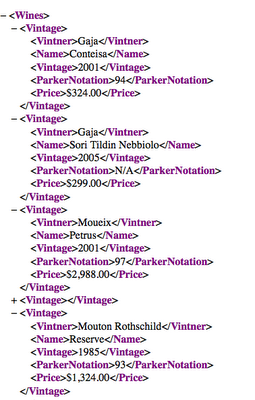
Note 1: In order for this to work, a small file called crossdomain.xml is in the same directory as the Wines.xml on the server. This file helps Flash Player mitigate cross domain scripting attacks. Describing what this file does is beyond the scope of this tutorial, however more can be read at http://livedocs.adobe.com/flash/8/main/wwhelp/wwhimpl/common/html/wwhelp.htm?context=LiveDocs_Parts&file=00001621.html
Note 2: All the wines on this list are favorites and make great gifts for Adobe Evangelists who post tutorials to help you with your work ;-p
3. Copy the URL (Command -C on Mac or Control-C on PC)
4. At the bottom of the Flash Builder IDE, click on the Connect to Data Services link shown below.
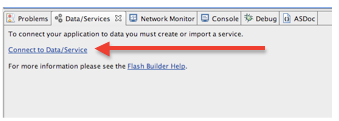
5. This will bring up a dialog box with a number of choices for services. Select the HTTPService option as shown below:
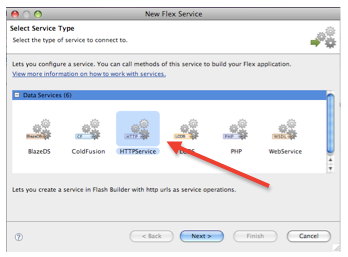
6. Click “Next” and then fill in the next screen by adding the name of the service (“srv” in this case) and add the URL.
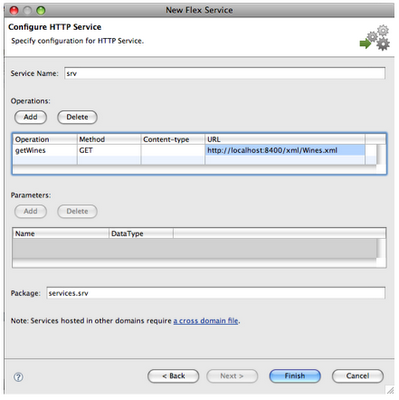
7. After completing this operation by clicking “Finish”, you will see the data services in the panel at the bottom.
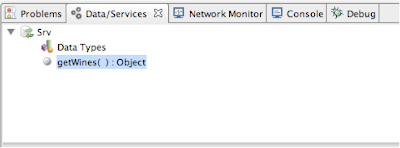
8. Next we need to add an object to bind our data to. Switch to Design view and drag a DataGrid
9. Highlight the DataGrid, then right-click (Control Click on Mac) the DataGrid object and select Bind To Data from the menu as shown below:
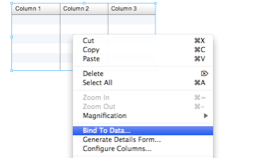
10. This will bring up the “Bind to Data” dialog box. Click on “Configure Return Type” to configure the datatype for the returned object.
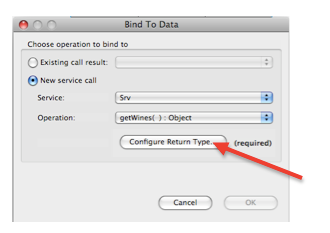
11. The next dialog will prompt you for a datatype. NOTE: on other projects, you might wish to use one of the default data types; however on this one, we are going to create our own object type called “WinesArray” as shown below.
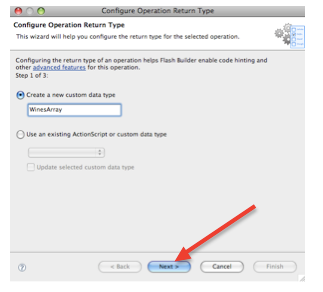
12. Click “Next”
13. The next dialog will invoke the service request to get a sample of the data to inspect. For this lab exercise, select the radio button labeled “Enter complete URL …” and enter the URL of the XML file in the “URL to fetch” box below and click “Next”.
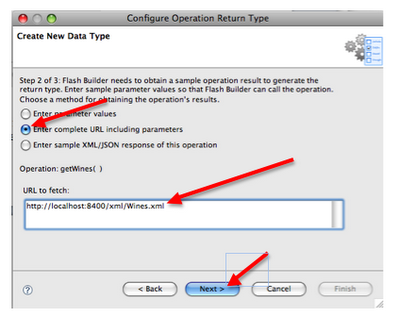
14. Flash Builder will go to the URL, retrieve a sample of data, and break down its structure for you. In this case, it has selected that it may be an array. Rather than accept the first option as is, use the drop down list to select a context root of “Vintage” as shown below.
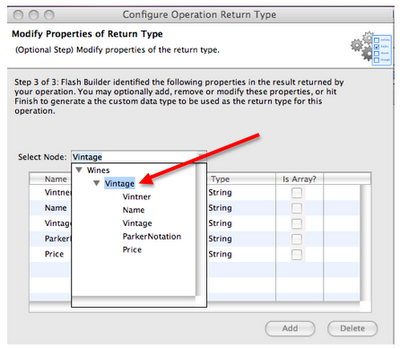
15. Now you will have the following
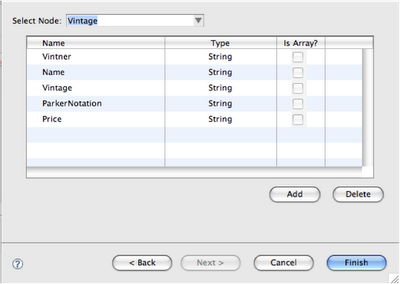
16. Click “Finish”
17. Close the last dialog by clicking “OK”
18. Your project should now reflect the DataGrid being bound to the data as shown below:
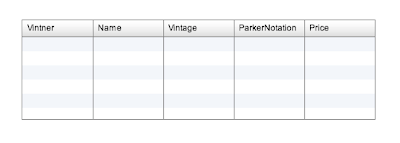
19. Run the project and you Flex 4/AIR application will build and display the XML from the server.


